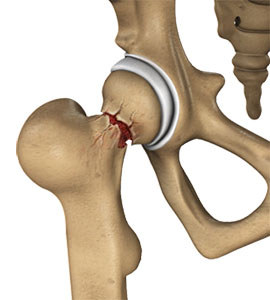Hip Injuries

The different hip injuries include muscle strains , hip dislocation, gluteus medius tear, hip labral tear and chondral injuries.
What is Muscle Strain?
A tear in the muscle fibers caused by either a fall or direct blow to the muscle, overstretching and overuse injury is called a strain. Muscle strains often occur in the hip region whenever a muscle contracts suddenly from its stretched position. It can be mild, moderate or severe and depends on the level of injury. The chances of having a hip muscle strain becomes high if you have had a previous injury in the area or if there is no warm-up before exercising.
What is Hip Dislocation?
The hip joint is a ball and socket joint. The "ball" is the head of the femur, or thighbone, and the "socket" is the cup shaped acetabulum. The joint is surrounded by muscles, ligaments, and tendons that support and hold the bones of the joint in place. Hip dislocation occurs when the head of the femur moves out of the socket. The femoral head can dislocate either backward (posterior dislocation) or forward (anterior dislocation).
What is Gluteus Medius Tear?
A gluteus medius tear is a condition characterized by severe strain on the gluteus medius muscle that results in partial or complete rupture of the muscle.
The gluteus medius is one of the major muscles of the hip and is essential for movement of the lower body and keeping the pelvis level during ambulation. The gluteus medius muscle arises from the top of the pelvic bone and attaches to the outer side of the thighbone or femur at the greater trochanter by the gluteus medius tendon. The muscle functions as a hip abductor, controlling side to side movement of the hip and providing stabilization to the joint. Gluteus medius tears often occur at the tendinous attachment to the greater trochanter of the femur bone.
What is a Hip Labral Tear?
A hip labral tear is an injury to the labrum, the cartilage that surrounds the outside rim of your hip joint socket.
Causes of Hip Labral Tears
A tear in the labrum of the hip can result from:
- traumatic injury, such as a motor vehicle accident or from participating in sports such as football, soccer, basketball and snow skiing
- repetitive movements
- weight-bearing activities over time can lead to joint wear and tear
- degenerative changes to the hip joint in older patients
What are Chondral Lesions or Injuries?
A chondral injury refers to an injury of the articular cartilage covering the joint.
Causes of Chondral Lesions or Injuries
Chondral injuries can result from various hip conditions such as labral tears, loose bodies, posterior dislocation, slipped capital femoral epiphysis (SCFE), dysplasia, osteonecrosis, and degenerative arthritis.
Articular cartilage covering the hip joint can also be damaged by a direct blow to the outer part of the thigh. Femoroacetabular impingement or FAI can also cause chondral injuries. This is a condition characterized by excessive friction in the hip joint causing pain and decreased range of motion. The femoral head and acetabulum rub against each other eventually causing damage to the cartilage.







